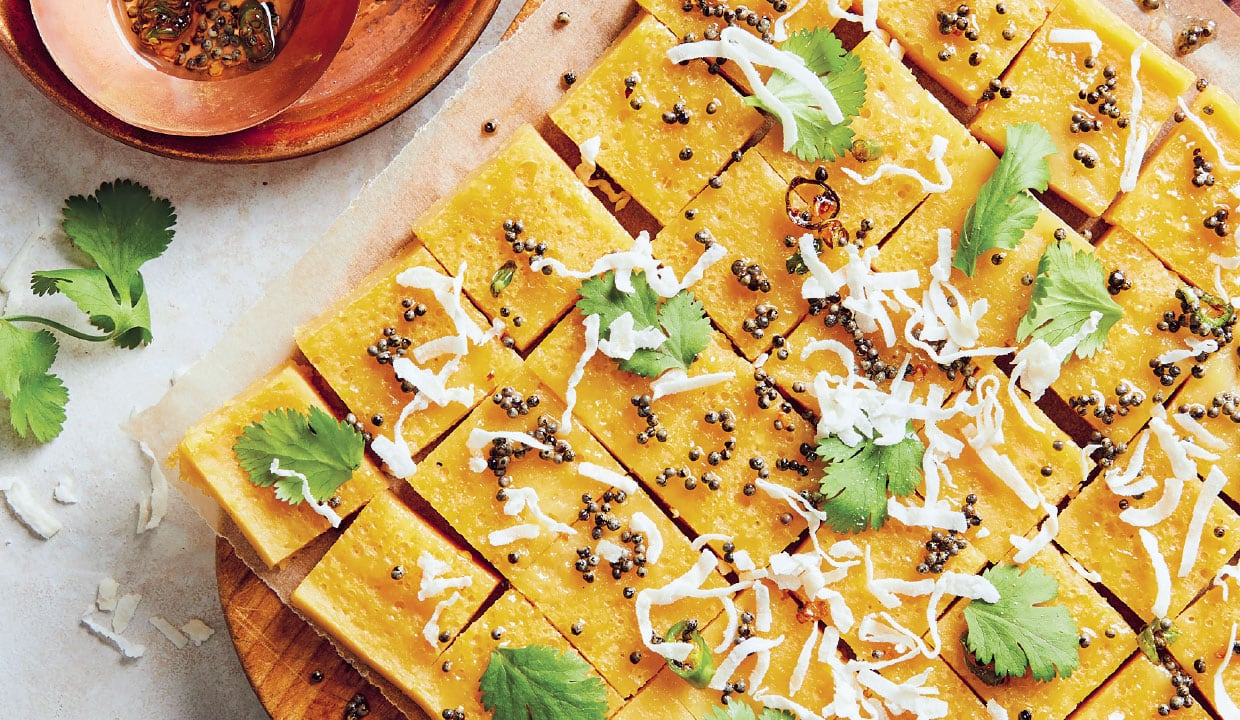
Chickpea Cakes
Dhokla, a light and airy steamed chickpea cake from the state of Gujarat, is packed full of flavour, and its sunny yellow colour is a lovely metaphor for India’s vibrant culinary scene. Buddhist monks appreciate dhokla for its simple ingredients, gentle flavours, easily digestible ingredients, and the fact that it fits so well into their plant based lifestyle. The foundation for dhokla is besan, also known as gram flour or chickpea flour. It’s naturally gluten-free, high in protein, and has a slightly nutty flavour, which offers depth to the recipes in which it’s used. Besan is widely available at Asian specialty markets.
Ingredients
- 1 cup (115 g) besan
- 1 cup (240 g) plain plant-based yogurt
- 1 tablespoon freshly squeezed lemon juice
- 2 teaspoons sugar
- 1 teaspoon salt
- 1⁄2 cup (120 ml) water, plus water as needed
- 1 teaspoon eno or substitute (for 1 tsp eno substitute combine 1⁄2 teaspoon baking soda and 1⁄2 teaspoon lemon juice or vinegar)
- 1 tablespoon vegetable oil
- 1 teaspoon black mustard seeds
- 1 green chilli, seeded and finely chopped
- Grated coconut, for garnish
- Fresh cilantro leaves, for garnish
To serve
- Vulputate dignissim suspendisse in est ante
- Purus sit amet volutpat consequat
- Nunc scelerisque viverra mauris in aliquam sem fringilla ut morbi
- Maecenas ultricies mi eget mauris pharetra et
- Vulputate dignissim suspendisse in est ante
- Proin nibh nisl condimentum id venenatis a condimentum
- Nunc scelerisque viverra mauris in aliquam sem fringilla ut morbi
- Purus sit amet volutpat consequat
- Proin nibh nisl condimentum id venenatis a condimentum
In a large bowl, stir together the besan, plant-based yogurt, lemon juice, sugar, and salt. Mix well until everything is incorporated. Slowly add the water in a steady stream while stirring to form a batter similar to a pancake batter. If the batter is too thick, add a little more water, 1 tablespoon at a time, to achieve the desired result. Let the batter rest at room temperature for 15 minutes.
Prepare the steamer and lightly grease a 9 x 9-inch (23 x 23-cm) steaming dish with vegetable oil. Choose a large deep pan or pot with a lid that fits securely. Pour 1–2 inches (2.5–5 cm) of water into the pot. The water level should be lower than your steaming plate’s bottom when it’s inserted into the pot (the food should not touch the water at all during steaming). If you don’t have a steamer, you can use a regular cake pan or a deep dish that fits into your pot. Grease it lightly with oil to prevent sticking.
Stir in the eno (or substitute) and pour the batter into the steaming dish. If using a substitute, the chemical reaction between the acid (lemon/vinegar) and the base (baking soda) mimics eno’s effervescence, facilitating the rise and fluffiness of the dhokla. Whether you’re using eno or a substitute, add it right before you’re ready to steam the dhokla, as the reaction starts immediately.
Pour the batter into the greased dish. Carefully place the filled dish in the steamer pot. Cover the pot with the lid. It’s important to have a tight seal for effective steaming, so make sure the lid fits well. Turn the heat to medium-high. Once the water starts boiling, reduce the heat to medium-low and let the dhokla steam.
Steam the batter for 15–20 minutes, or until a toothpick inserted into the centre comes out clean. The cooking time will depend on the size of your dhokla dish and the thickness of the batter. Remove the dish from the steamer and let the dhokla rest at room temperature for at least 10 minutes
While the dhokla cools, prepare the topping by heating the oil in a pan over medium heat. Add the mustard seeds and, once they start to pop, about 30 seconds, add the green chilli and sauté until just tender, about 1 minute. Remove from the heat. Cut the dhokla into bite-size squares and arrange on a serving platter. Drizzle the topping over the dhokla and garnish with coconut flakes and cilantro. Serve immediately. The dhokla will keep in a covered container in the refrigerator for up to 3 days



